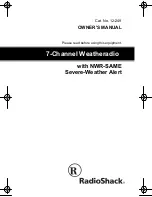
7
GTR 8000 Base Radio Operation
This chapter details tasks that you will perform once the GTR 8000 Base Radio is installed and operational on
your system.
7.1 Base Radio Operational States for Trunked
Simulcast
GTR 8000 Base Radio modules can be in any one of the following four operational states:
• Standby
• Idle
• Assigned
• Isolated
During initialization, the base radio powers up into the
standby
state and waits for a status packet from the
comparator. When initial contact with the comparator has been made, the base radio enters
idle
mode. The base
radio sends a status message back to the comparator indicating that it is ready for the assignment.
After a base radio has been
assigned
, it can begin to handle inbound/outbound traffic. In the case where the base
radio fails to receive status packets from the comparator, the base radio enters
isolated
mode and dekeys. This
isolated mode is reported in the Unified Event Manager.
If the base radio becomes operational again, and receives the status packets from the comparator, it again replies with
a channel status message. The base radio returns to the idle state and is ready for an assignment from the comparator.
Extended Control Channel
For IP simulcast subsystems with 16 to 32 subsite capacity, the Transport Network requires longer than 1 second
to recover following a failure due to greater payload delivery. To compensate for the subscriber unit scatter, the
subscriber units are required to remain on the site for a longer duration following a control channel loss. A message
is used to instruct the subscriber units to remain on the site for 20 seconds following the loss of a control channel.
The base radio automatically transmits this message upon loss of packets from the prime site.
7.2 Base Radio Operational States for Trunked
Repeater and HPD
A GTR 8000 Base Radio can be in one of four operational states:
• Standby
• Idle
• Assigned
• Isolated
6871022P86-A - November 2012
7-1
Summary of Contents for GTR 8000
Page 2: ......
Page 4: ......
Page 6: ......
Page 14: ......
Page 18: ......
Page 22: ......
Page 26: ......
Page 60: ......
Page 177: ...5 8 1 3 VHF Tuning Procedure Figure 5 1 Preselector Tuning VHF 6871022P86 A November 2012 5 7 ...
Page 181: ...5 8 2 3 UHF Tuning Procedure Figure 5 2 Preselect Tuning UHF 6871022P86 A November 2012 5 11 ...
Page 230: ......
Page 234: ......
Page 244: ......
Page 286: ......
Page 300: ......
Page 338: ......
















































